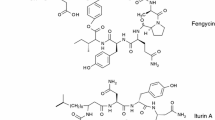Summary
An efrotomycin fermentation was characterized through physical, chemical and biochemical studies. Growth of the actinomycete,Nocardia lactamdurans occurred during the first 50 h of the fermentation cycle at the expense of glucose, protein, and triglycerides. The initiation of efrotomycin biosynthesis was observed when glucose dropped to a low concentration. Upon glucose depletion, cell growth ceased and a switch in the respiratory quotient occurred. Efrotomycin biosynthesis was supported by the utilization of soybean oil and starch. Analysis of triglyceride metabolism showed that no diglycerides or monoglycerides accumulated during the fermentation. The activity of extracellular enzymes (lipase, protease, and amylase) increase during the cell growth phase and decreased significantly after 150 h. The concentrations of DNA, tetrahydro-vitamin K2 (a membrane component), and free amino acids in the supernatant increased dramatically late in the fermentation cycle (225 h), indicating massive cell lysis. During this same time period, a reduction in cellular respiratory activity and efrotomycin biosynthesis were observed.
Similar content being viewed by others
References
Aharonowitz, Y. 1980. Nitrogen metabolite regulation of antibiotic biosynthesis. Ann. Rev. Microb. 34: 209–233.
Berger, J., H. Leber, S. Teitel, H. Maehr and E. Grunberg. 1973. A new antibiotic X-5108 of streptomyces origin. 1. Production, isolation, and properties. J. Antibiot. 26: 15–22.
Buckland, B., T. Brix, H. Fastert, K. Gbewonyo, G. Hunt and D. Jain. 1985. Fermentation exhaust gas analysis using mass spectrometry. Bio. Technol. 3: 982–988.
Burton, K. 1957. A study on the conditions and mechanism of the diphenylamine reaction for the colorimetric estimation of deoxyribonucleic acid. J. Biochem. 62: 315–323.
Calam, C.. 1987. Process Development in Antibiotic Fermentations. Cambridge University Press, Cambridge, U.K.
Cover, W., A. Kirpekar, H. George and R. Steiber. 1990. Calcium inhibition of efrotomycin byNocardia lactamdurans. J. Industr. Microbiol. 7: 41–44.
Cromwell, G., H. Monegue and T. Stahly. 1985. Efficacy of efrotomycin as a growth promotant for swine. J. Anim. Sci. 61S: 313–314.
Darland, G. and L. Kaplan. 1990. The biosynthesis origin of the pyridone ring in efrotomycin. J. Cell. Biochem. Suppl. 14A: 115.
Drew, S. and A. Demain. 1977. Effect of primary metabolites on secondary metabolism. Ann. Rev. Microbiol. 31: 343–356.
Foster, A., E.S. Brokken, G.F. Ericsson, J.M. Preston, R.A. Roncalli and I.H. Sutherland. 1986. A review of Efrotomycin efficacy trials. Proceedings of the 9th Congress of the International Pig Veterinary Society, pp. 53.
Gerhardt, P. 1981. Diluents and biomass measurement. In: Manual of Methods for General Bacteriology, (Gerhardt, P. Ed.) pp. 504–507. ASM Washington, DC.
Ginther, C. 1979. Sporulation and the production of serine protease and cephamycin C byStreptomyces lactamdurans. Antimicrob. Ag. Chemother. 10: 522–526.
Goodfellow, M. and T. Cross. 1984. Classification. In: Biology of the Actinomycetes, (Goodfellow, M., Mordarski, M. and William, S., Eds.) pp. 8–131. Associated Press, NY.
Harris, R. and S. Adams. 1979. Microbial cells and metabolites by dichromate oxidation. Appl. Environ. Microbiol. 37: 237–243.
Jain, D. and B. Buckland. 1988. Scale-up of the efrotomycin fermentation using a computer-controlled pilot plant. Bioprocess Engineering. 3: 31–36.
Jain, D., J. Nielsen and B. Buckland. 1990. Kinetics of efrotomycin synthesis in a synthetic fermentation medium. Bioprocess Engineering (in press)
Lepage, G. and C. Roy. 1988. Specific methylation of plasma nonesterified fatty acids in a one step reaction. J. Lipid Res. 29: 227–235.
Liu, P. and C. Hsieh. 1969. Inhibition of protease production of various bacteria by ammonium salts: Its effect on toxin production and virulence. J. Bacteriol. 99: 406–413.
Liu, C., T. Williams and R. Pitcher. 1979. 13C-NMR studies on the biosynthesis of aurodox (antibiotic X-5108). J. Antibiot. 32: 414–417.
Luria, S. 1960. Bacterial protoplasm-composition and organization. In: The bacteria, Volume 1. (Gunsalus, I. and Stanier, R., Eds.). pp. 18. Academic Press, New York.
Martin, J. and A. Demain. 1980. Control of antibiotic biosynthesis. Microbiol. Rev. 44: 230–251.
May, B. and W. Elliot. 1968. Characteristics of extracellular protease formation byBacillus subtilis and its control by amino acid repression. Biochem. Biophys. Acta 157: 607–615.
Miller, T. and B. Churchill. 1986. Substrates for large-scale fermentations In: Manual of Industrial Microbiology and Biotechnology (Demain, A. and Solomon, N., Eds), pp. 122–136. ASM Washington, DC.
Nielsen, J. and L. Kaplan. 1989. A resting cell system for efrotomycin biosynthesis. J. Antibiot. 42: 944–951.
Nielsen, J. 1990. Biosynthesis of a modified polyketide containing two amino acid-derived residues. J. Cell Biochem. Suppl. 14A: 119.
Smibert, R. and N. Krieg. 1981. General characterization. In: Manual of Methods for General Bacteriology (Gerhardt, P. Ed.) pp. 411–472. ASM Washington, DC.
Tiez, N. and E. Fiereck. 1966. A specific method for serum lipase determination. Clin Chim. Acta. 13: 352.
Wax, R., W. Maiese, R. Weston and J. Birnbaum. 1976. Efrotomycin, a new antibiotic fromStreptomyces lactamdurans. J. Antibiot. 29: 670–673.
Weinberg, E. 1970. Biosynthesis of secondary metabolites: role of trace metals. Advan. Microbiol. Physiol. 4: 1–44.
Yamada, Y., G. Inouye, Y. Tahara and K. Kondo. 1977. The structures of menaquinones with a tetrahydrogenated isoprenoid side-chain. Biochem. Biophys. Acta 488: 280–284.
Author information
Authors and Affiliations
Rights and permissions
About this article
Cite this article
Chartrain, M., Hunt, G., Horn, L. et al. Biochemical and physiological characterization of the efrotomycin fermentation. Journal of Industrial Microbiology 7, 293–299 (1991). https://doi.org/10.1007/BF01577658
Received:
Accepted:
Issue Date:
DOI: https://doi.org/10.1007/BF01577658




